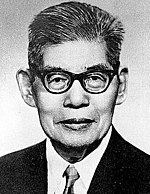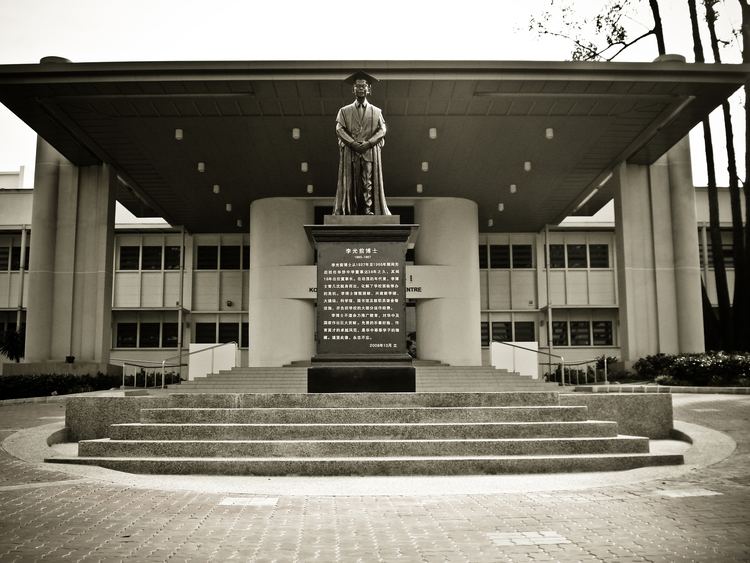Other names Lee Geok Kun Spouse Tan Ai Leh (m. 1920) Occupation Businessman Parents Lee Kuo Chuan | Name Lee Chian Grandchildren Tih Shih Lee Died June 2, 1967, Singapore | |
 | ||
Children Lee Seng Wee, Lee Seng Tee | ||
A night at the lee kong chian natural history museum
Tan Sri Dato' Dr Lee Kong Chian (18 October 1893 – 2 June 1967), also known as Li Guangqian or by his alias Lee Geok Kun (Li Yukun), was a prominent Chinese businessman and philanthropist active in Malaya and Singapore from the 1930s to the 1960s. He was the founder of the Lee Foundation and one of the richest men in Southeast Asia in the 1950s and 1960s. He was also the son-in-law of Tan Kah Kee, another well-known Chinese businessman and philanthropist based in Southeast Asia.
Contents
- A night at the lee kong chian natural history museum
- Vlog1 museum lee kong chian natural history museum
- Early life
- Career
- Supporting education
- Later life
- Legacy
- Places named after Lee Kong Chian
- Places named after Lee Kong Chians father
- References

Vlog1 museum lee kong chian natural history museum
Early life
Lee was born in Furong Village, Nan'an, Fujian Province towards the end of the Qing dynasty of China. His father was Lee Kuo Chuan (李国专; 李國專; Lǐ Guózhuān). He received his early education in private schools in his hometown. In 1903, at the age of 10, he came to Singapore, then a British colony, to join his father. Lee studied at the now defunct Anglo-Tamil School and Chung Cheng High School.
Lee returned to China in 1909 to complete his education under a scholarship, but it had to end in 1911 as the Xinhai Revolution broke out. In China, Lee studied at Chi Nan College in Nanjing and later the Railway and Mining College in Tangshan, which was then one of the top colleges in China and a forerunner of the present-day Southwest Jiaotong University and North China University of Science and Technology.
Upon returning to Singapore, Lee worked as a teacher at Tao Nan School and as a translator at a Chinese-language newspaper company. He also worked as an assistant field surveyor with the Public Works Department. In 1915, he joined the China Guohua Company owned by Tan Kah Kee, and became Tan's protégé. He was promoted to manager of the Tan Kah Kee Rubber Company in 1917. Three years later, he married Tan's daughter, Tan Ai Leh (陈爱礼; 陳愛禮; Chén Àilǐ).
Career
Seven years later, Lee set up his own rubber smoking house in Muar, Johor, Malaya, which became the Nam Aik Rubber Company in 1928. His enterprises of rubber planting and manufacture, pineapple planting and canning soon expanded to other parts of Southeast Asia, including Singapore, Malaya, North Borneo, Indonesia and Thailand. He was known as "Southeast Asia's Rubber and Pineapple King". He became one of the richest men in the region, with the Lee Rubber Company becoming a multimillion-dollar business which he started in 1931. His brother George Lee joined him at the company. At the height of their fortune, the company's worth was estimated to be S$600 million.
Lee also went into banking. He became the general manager and vice-chairman of Huayi Bank. In 1933, he was appointed as the vice-chairman of Oversea-Chinese Banking Corporation (OCBC), a corporation formed from the merger of three Chinese banks.
Supporting education
In 1934, Lee became the chairman of the board of directors of The Chinese High School (now Hwa Chong Institution), a post he held until 1957. In 1939, Lee founded Guozhuan Primary School in his hometown, Furong Village. In 1941, Lee donated his properties in River Valley, Singapore for the establishment of Nan Chiau Teachers' Training College (present Nan Chiau High School). He gave lectures in Columbia University during World War II while he was stranded in the United States. Lee became the Vice-Chancellor of the University of Singapore (now the National University of Singapore) and donated S$1 million for the development of a medical college on the college's grounds. Other institutions received financial support from the Lee Foundation, including the National University of Singapore, Anglo-Chinese School, St. Margaret's Secondary School, Methodist Girls' School, Singapore Chinese Girls' School, Tao Nan School, Anglican High School and The Chinese High School. The Lee Kong Chian School of Business of the Singapore Management University was named in his honour.
Like Tan Kah Kee, Lee poured his wealth into education and other philanthropic work. He set up the Lee Foundation in Singapore in 1952 and in Malaya in 1960. In 1965, the Lee Foundation Limited was established in Hong Kong. Lee spearheaded free public library services for the nation when he donated S$375,000 through the Lee Foundation to allow the Singapore government to build the Old National Library building at Stamford Road. Between 1952 and 1993, the Foundation donated sums amounting to S$300 million to various causes with no conditions attached.
Later life
Lee's work and generous contributions to education and society were recognised. He was conferred an honorary Doctor of Laws by the University of Malaya in 1958. In 1964, Malaysia's Yang di-Pertuan Agong (head of state), Putra of Perlis, awarded Lee the title Panglima Mangku Negara (PMN), hence Lee was known by the honorific Tan Sri. Prior to that, Lee had been made Dato' by the Sultans of Johor and Kelantan in 1957 and 1959 respectively. He became the chairman of OCBC Bank in 1938 and remained in that position until his death. In 1965, Lee was conferred another honorary degree, Doctor of Letters, by the University of Singapore in recognition of his services to the university and his contributions to arts and education.
Legacy
Lee died in 1967 and is survived by three sons and three daughters.
Places named after Lee Kong Chian
Places named after Lee Kong Chian's father
There are also some places named after Lee's father, Lee Kuo Chuan, including:
